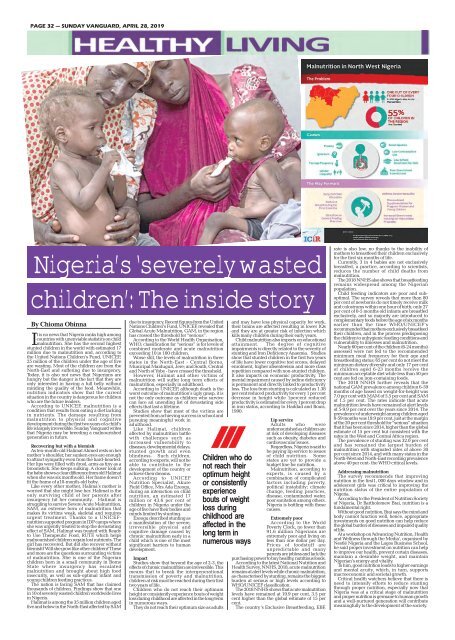Create successful ePaper yourself
Turn your PDF publications into a flip-book with our unique Google optimized e-Paper software.
PAGE 32 — SUNDAY VANGUARD, APRIL 28, 2019<br />
Nigeria’s ‘severely wasted<br />
children’: The inside story<br />
By Chioma Obinna<br />
It is no news that Nigeria ranks high among<br />
countries with unenviable statistics on child<br />
malnutrition. She has the second highest<br />
stunted children in the world with estimated 17<br />
million due to malnutrition <strong>and</strong>, according to<br />
the United Nations Children’s Fund, UNICEF,<br />
25 million of the children under the age of five<br />
are wasting. Most of the children are from the<br />
<strong>No</strong>rth-East <strong>and</strong> suffering due to insurgency.<br />
Today, it is also not news that Nigerians are<br />
hungry but the danger is the fact that they are<br />
only interested in having a full belly without<br />
minding the quality of the food. Meanwhile,<br />
nutrition indicators show that the current<br />
situation in the country is dangerous for children<br />
who are the future leaders.<br />
According to UNICEF, malnutrition is a<br />
condition that results from eating a diet lacking<br />
in nutrients. The damage resulting from<br />
malnutrition to physical <strong>and</strong> cognitive<br />
development during the first two years of a child’s<br />
life is largely irreversible. Sunday Vanguard writes<br />
that Nigeria may be breeding a malnourished<br />
generation in future.<br />
Recovering but with a blemish<br />
As ten-month-old Halimat Ahmed rests on her<br />
mother’s shoulder, her sunken eyes are enough<br />
to attract sympathy even from the hard-hearted.<br />
Her lips were filled with drool, arms as tiny as a<br />
broomstick. She keeps sulking. A closer look at<br />
the baby shows a clear difference from old Halimat<br />
when she was six months old. Her frame doesn’t<br />
fit the frame of a10-month-old baby.<br />
Like every other mother, Halima’s mother is<br />
worried that she might lose her. Halimat is the<br />
only surviving child of her parents after<br />
insurgency hit her community. Halimat is<br />
struggling to survive Severe Acute Malnutrition,<br />
SAM, an extreme form of malnutrition that<br />
makes its victims weak, skeletal <strong>and</strong> requires<br />
urgent treatment. Thanks to a UNICEFnutrition<br />
supported program in IDP camps where<br />
she was urgently treated to stop the devastating<br />
effect of SAM, Halimat was treated with Ready<br />
to Use Therapeutic Food, RUTF, which helps<br />
malnourished children regain lost nutrients. The<br />
girl has recovered. But did she recover without<br />
blemish? Will she grow like other children? These<br />
<strong>and</strong> more are the questions surrounding victims<br />
of malnutrition. She is one of the Nigerian<br />
children born in a small community in Borno<br />
State where insurgency has escalated<br />
malnutrition <strong>and</strong> brought about high food<br />
insecurity, as well as sub-optimal infant <strong>and</strong><br />
young children feeding practices.<br />
The nation is facing SAM that has claimed<br />
thous<strong>and</strong>s of children. Findings show that one<br />
in 10 of severely wasted children worldwide lives<br />
in Nigeria.<br />
Halimat is among the 35 million children aged<br />
five <strong>and</strong> below in the <strong>No</strong>rth-East affected by SAM<br />
due to insurgency. Recent figures from the United<br />
Nations Children’s Fund, UNICEF, revealed that<br />
Global Acute Malnutrition, GAM, in the region<br />
has crossed the threshold for “serious”.<br />
According to the World Health Organisation,<br />
WHO, classification for “serious” is for levels of<br />
combined moderate <strong>and</strong> acute malnutrition<br />
exceeding 10 in 100 children.<br />
Worse still, the levels of malnutrition in three<br />
<strong>states</strong> in the <strong>No</strong>rth-East - Central Borno,<br />
Municipal Maiduguri, Jere; <strong>and</strong> South, Central<br />
<strong>and</strong> <strong>No</strong>rth of Yobe - have crossed the threshold.<br />
However, Halimat <strong>and</strong> other victims of<br />
malnutrition will suffer long term effects of<br />
malnutrition, especially in adulthood.<br />
According to UNICEF, although death is the<br />
worst outcome of malnutrition’s ugly grasp, it is<br />
not the only outcome as children who survive<br />
can face an unending list of devastating side<br />
effects that last a lifetime.<br />
Studies show that most of the victims are<br />
prevented from achieving success in school <strong>and</strong><br />
pursuing meaningful work in<br />
adulthood.<br />
Like Halimat, children<br />
affected by malnutrition battle<br />
with challenges such as<br />
increased vulnerability to<br />
diseases, developmental delays,<br />
stunted growth <strong>and</strong> even<br />
blindness. Such children,<br />
according to experts, will not be<br />
able to contribute to the<br />
development of the country or<br />
achieve their dreams.<br />
According to UNICEF<br />
Nutrition Specialist, Akure<br />
Field Office, Mrs Ada Ezeogu,<br />
during an interaction on child<br />
nutrition, an estimated 17<br />
million or 43.6 per cent of<br />
children in Nigeria under the<br />
age of five have their bodies <strong>and</strong><br />
minds limited by stunting.<br />
Ezeogu described stunting as<br />
a manifestation of the severe,<br />
irreversible physical <strong>and</strong><br />
cognitive damage caused by<br />
chronic malnutrition early in a<br />
child which is one of the most<br />
significant barriers to human<br />
development.<br />
Impact<br />
Studies show that beyond the age of 2-3, the<br />
effects of chronic malnutrition are irreversible. This<br />
means that to break the intergenerational<br />
transmission of poverty <strong>and</strong> malnutrition,<br />
children at risk must be reached during their first<br />
two years of life.<br />
Children who do not reach their optimum<br />
height or consistently experience bouts of weight<br />
loss during childhood are affected in the long term<br />
in numerous ways.<br />
They do not reach their optimum size as adults<br />
Children who do<br />
not reach their<br />
optimum height<br />
or consistently<br />
experience<br />
bouts of weight<br />
loss during<br />
childhood are<br />
affected in the<br />
long term in<br />
numerous ways<br />
<strong>and</strong> may have less physical capacity for work,<br />
their brains are affected resulting in lower IQs<br />
<strong>and</strong> they are at greater risk of infection which<br />
kills many children during their early years.<br />
Child malnutrition also impacts on educational<br />
attainment. The degree of cognitive<br />
impairments is directly related to the severity of<br />
stunting <strong>and</strong> Iron Deficiency Anaemia. Studies<br />
show that stunted children in the first two years<br />
of life have lower cognitive test scores, delayed<br />
enrolment, higher absenteeism <strong>and</strong> more class<br />
repetition compared with non-stunted children.<br />
It also impacts on economic productivity. The<br />
mental impairment caused by iodine deficiency<br />
is permanent <strong>and</strong> directly linked to productivity<br />
loss. The loss from stunting is calculated as 1.38<br />
per cent reduced productivity for every 1 per cent<br />
decrease in height while 1percent reduced<br />
productivity is estimated for every 1percent drop<br />
in iron status, according to Haddad <strong>and</strong> Bouis,<br />
1990.<br />
Lip service<br />
Adults who were<br />
undernourished as children are<br />
at risk of developing diseases<br />
such as obesity, diabetes <strong>and</strong><br />
cardiovascular issues.<br />
Regardless, Nigeria is said to<br />
be <strong>pay</strong>ing lip service to issues<br />
of child nutrition. Some<br />
<strong>states</strong> are yet to provide a<br />
budget line for nutrition.<br />
Malnutrition, according to<br />
experts, is caused by a<br />
combination of complicated<br />
factors including poverty,<br />
political instability; climate<br />
change, feeding practices,<br />
disease, contaminated water,<br />
poor sanitation among <strong>others</strong>.<br />
Nigeria is battling with these<br />
causes.<br />
Extremely poor<br />
According to the World<br />
Poverty Clock, no fewer than<br />
91.6 million Nigerians are<br />
extremely poor <strong>and</strong> living on<br />
less than one dollar per day.<br />
Prices of foodstuff are<br />
unpredictable <strong>and</strong> many<br />
parents are jobless <strong>and</strong> lack the<br />
purchasing power to buy healthy, nutritious foods.<br />
According to the latest National Nutrition <strong>and</strong><br />
Health Survey, NNHS, 2018, acute malnutrition<br />
remains at alert levels while chronic malnutrition,<br />
as characterised by stunting, remains the biggest<br />
burden at serious or high levels according to<br />
WHO/UNICEF classification.<br />
The 2018 NNHS shows that acute malnutrition<br />
levels have remained at 19.9 per cent, 3.5 per<br />
cent higher than the global estimate of 15 per<br />
cent.<br />
The country’s Exclusive Breastfeeding, EBF,<br />
rate is also low, no thanks to the inability of<br />
m<strong>others</strong> to breastfeed their children exclusively<br />
for the first six months of life.<br />
Currently, 3 in 4 babies are not exclusively<br />
breastfed, a practice, according to scientists,<br />
reduces the number of child deaths from<br />
malnutrition.<br />
The 2018 NNHS also shows that breastfeeding<br />
remains widespread among the Nigerian<br />
population.<br />
Child feeding indicators are poor <strong>and</strong> suboptimal.<br />
The survey reveals that more than 80<br />
per cent of newborns do not timely receive milk<br />
<strong>and</strong> colostrums within one hour of birth; only 27<br />
per cent of 0-5 months old infants are breastfed<br />
exclusively, <strong>and</strong> so majority are introduced to<br />
complementary foods before the age of six months<br />
earlier than the time WHO/UNICEF’s<br />
recommended that m<strong>others</strong> exclusively breastfeed<br />
their children, <strong>and</strong> in the process predisposing<br />
the children to unhygienic feeding conditions <strong>and</strong><br />
vulnerability to illnesses <strong>and</strong> malnutrition.<br />
Nearly 60 per cent of the children (6-24 months)<br />
assessed were not fed to the recommended<br />
<strong>minimum</strong> meal frequency for their age <strong>and</strong><br />
breastfeeding status; 65 per cent do not meet the<br />
<strong>minimum</strong> dietary diversity <strong>and</strong> only 17 per cent<br />
of children aged 6-23 months receive the<br />
<strong>minimum</strong> acceptable diet while less than 50 per<br />
cent are fed on iron-containing foods.<br />
The 2018 NNHS further reveals that the<br />
national GAM prevalence among children 6-59<br />
months of age based on weight-for-height was<br />
7.0 per cent with MAM of 5.5 per cent <strong>and</strong> SAM<br />
of 1.5 per cent. The rates indicate that acute<br />
malnutrition levels have remained at alert levels<br />
of 5-9.9 per cent over the years since 2014. The<br />
prevalence of underweight among children aged<br />
0-59 months was 19.9 per cent, just at the margin<br />
of the 20 per cent threshold for “serious” situation<br />
that it has been since 2014, higher than the global<br />
estimate of 15 per cent but consistent with the<br />
rates in the West <strong>and</strong> Central Africa region.<br />
The prevalence of stunting was 32.0 per cent<br />
<strong>and</strong> has remained the largest burden of<br />
malnutrition with stagnated rates of above 30<br />
per cent since 2014, <strong>and</strong> with many <strong>states</strong> in the<br />
<strong>No</strong>rth-West <strong>and</strong> <strong>No</strong>rth-East recording prevalence<br />
above 40 per cent- the WHO critical levels.<br />
Addressing malnutrition<br />
The survey recommends that improving<br />
nutrition in the first1, 000 days window <strong>and</strong> in<br />
adolescent girls was critical to improving the<br />
nutrition status of the entire population of<br />
Nigeria.<br />
According to the President of Nutrition Society<br />
of Nigeria, Dr Bartholomew Brai, nutrition is a<br />
fundamental right.<br />
Without <strong>go</strong>od nutrition, Brai says the mind <strong>and</strong><br />
body cannot function well, hence, appropriate<br />
investments on <strong>go</strong>od nutrition can help reduce<br />
the global burden of diseases <strong>and</strong> impaired quality<br />
of life.<br />
At a workshop on ‘Advancing Nutrition, Health<br />
<strong>and</strong> Wellness through the Media’, organised by<br />
Nestlé Nigeria <strong>and</strong> the La<strong>go</strong>s Business School,<br />
he said proper investment on nutrition can help<br />
to improve our health, prevent certain diseases,<br />
maintain a desirable weight, <strong>and</strong> maintain<br />
Nigerian’s energy <strong>and</strong> vitality.<br />
To him, <strong>go</strong>od nutrition leads to higher earnings<br />
<strong>and</strong> mental acuity, which, in turn, supports<br />
macroeconomic <strong>and</strong> societal growth.<br />
Critical health watchers believe that there is<br />
need to intensify efforts to reduce stunting<br />
through proper nutrition, especially now that<br />
Nigeria was at a critical stage of malnutrition<br />
<strong>and</strong> proper nutrition is germane to human growth<br />
<strong>and</strong> a well-nurtured generation will contribute<br />
meaningfully to the development of the society.


















